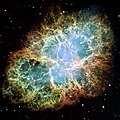Tập tin:Crab Nebula.jpg

Kích thước hình xem trước: 600×600 điểm ảnh. Độ phân giải khác: 240×240 điểm ảnh | 480×480 điểm ảnh | 768×768 điểm ảnh | 1.024×1.024 điểm ảnh | 2.048×2.048 điểm ảnh | 3.864×3.864 điểm ảnh.
Tập tin gốc (3.864×3.864 điểm ảnh, kích thước tập tin: 13,84 MB, kiểu MIME: image/jpeg)
| Đây là một hình ảnh đã được chọn làm hình ảnh chọn lọc và được giới thiệu trên Trang Chính của Wikipedia tiếng Việt. |
Lịch sử tập tin
Nhấn vào ngày/giờ để xem nội dung tập tin tại thời điểm đó.
| Ngày/giờ | Hình xem trước | Kích cỡ | Thành viên | Miêu tả | |
|---|---|---|---|---|---|
| hiện tại | 14:56, ngày 25 tháng 11 năm 2012 |  | 3.864×3.864 (13,84 MB) | Hawky.diddiz | Lossless optimization |
| 10:13, ngày 17 tháng 5 năm 2012 |  | 3.864×3.864 (14,61 MB) | Metrónomo | Higher quality | |
| 09:31, ngày 20 tháng 6 năm 2009 |  | 3.864×3.864 (6,18 MB) | Tryphon | Higher resolution. | |
| 21:26, ngày 9 tháng 3 năm 2006 |  | 2.224×2.212 (3,08 MB) | Stianbh | larger version | |
| 00:35, ngày 16 tháng 1 năm 2006 |  | 400×400 (23 kB) | DragonFire1024 | Image: A New View of the Helix Nebula Source: http://hubblesite.org/gallery/album/entire_collection/pr2004032d/ Copyright Notice: Material credited to STScI on this site was created, authored, and/or prepared for NASA under Contract NAS5-26555. Unless |
Trang sử dụng tập tin
Có hơn 100 trang liên kết đến tập tin này. Danh sách dưới đây chỉ hiển thị 100 liên kết đầu tiên đến tập tin này. Một danh sách đầy đủ có sẵn tại đây.
- 5430 Luu
- Albert Einstein
- Bán kính Schwarzschild
- Bức xạ phông vi sóng vũ trụ
- Bức xạ điện từ
- Charles Messier
- Chân trời sự kiện
- Chương trình Apollo
- Cơ học lượng tử
- Cực quang
- Danh sách chòm sao
- Deimos (vệ tinh)
- Dịch chuyển đỏ
- Electron
- Elip
- Eratosthenes
- Eris (hành tinh lùn)
- Giả thuyết tinh vân
- Giải Nobel Vật lý
- Hoàng đạo
- Hà Nội
- Hành tinh
- Hành tinh lùn
- Hành tinh ngoài Sao Hải Vương
- Hệ Mặt Trời
- Isaac Newton
- Johannes Kepler
- Khoa học
- Không–thời gian
- Khảo sát Bầu trời Kỹ thuật số Sloan
- Kính viễn vọng không gian Hubble
- Kỷ nguyên Planck
- Leonhard Euler
- Lạp Hộ
- Lỗ sâu
- Lỗ trắng
- Lỗ đen
- Lỗ đen siêu khối lượng
- Messier 87
- Mặt Trăng
- Mặt Trời
- Ngân Hà
- Ngũ hành
- Nhật thực
- Nhị thập bát tú
- Năng lượng
- Nước trên Sao Hỏa
- Omar Khayyám
- Phobos (vệ tinh)
- Phản vật chất
- Pythagoras
- Sao
- Sao Diêm Vương
- Sao Hải Vương
- Sao Hỏa
- Sao Kim
- Sao Mộc
- Sao Thiên Vương
- Sao Thổ
- Sao chổi
- Sao chổi Shoemaker-Levy 9
- Sao lùn trắng
- Sao neutron
- Sao quark
- Sao đôi quang học
- Sao đặc
- Siêu tân tinh
- Stephen Hawking
- Sự hình thành và tiến hóa của Hệ Mặt Trời
- Thiên hà
- Thiên hà Tiên Nữ
- Thiên thể Messier
- Thiên văn học
- Thuyết nhật tâm
- Thám hiểm không gian
- Thấu kính hấp dẫn
- Tia X
- Tinh vân
- Tiến hóa sao
- Tiểu hành tinh
- Triton (vệ tinh)
- Trái Đất
- Trạm vũ trụ Quốc tế
- Tốc độ ánh sáng
- Vành đai Kuiper
- Vành đai tiểu hành tinh
- Vũ trụ
- Vũ trụ quan sát được
- Vật chất
- Vật chất tối
- Vật lý học
- Vật lý thiên văn
- Vụ Co Lớn
- Vụ Nổ Lớn
- Xích vĩ
- Đài thiên văn Paris
- Đám mây Oort
- Độ nghiêng trục quay
- Bản mẫu:Hệ Mặt Trời
- Thể loại:Nhà thiên văn học theo quốc gia
Xem thêm liên kết đến tập tin này.
Sử dụng tập tin toàn cục
Những wiki sau đang sử dụng tập tin này:
- Trang sử dụng tại af.wiki.x.io
- 1054
- Wikipedia:Uitgesoekte herdenkings/22 April
- Wikipedia:Uitgesoekte herdenkings/Julie
- Wikipedia:Uitgesoekte herdenkings/April
- Wikipedia:Uitgesoekte herdenkings/4 Julie
- Supernova
- Ster
- Wikipedia:Beeld van die week/2012
- Wikipedia:Voorbladbeeld week 2 2012
- Newel
- Kompakte ster
- Veranderlike ster
- Lys van Messier-voorwerpe
- Krapnewel
- Portaal:Sterrekunde/Inleiding
- Portaal:Sterrekunde
- Hemelliggaam
- Lys van planetêre newels
- SN 1054
- Supernova-oorblyfsel
- Sterevolusie
- Trang sử dụng tại als.wiki.x.io
- Trang sử dụng tại am.wiki.x.io
- Trang sử dụng tại anp.wiki.x.io
- Trang sử dụng tại ar.wiki.x.io
- مجرة
- نجم
- تطور النجوم
- ثلاثي الكربون
- فجر
- مستعر أعظم
- بوابة:علم الفلك/مقالة مختارة
- شهاب
- مطلع مستقيم
- جمعية منسا الدولية
- علم الفلك خارج المجري
- عنقود نجمي
- فيلا (أقمار اصطناعية)
- الشلياق
- خرزات بيلي
- راية الأرض
- سمت
- نظرية الحالة الثابتة
- حياة الحيوان الكبرى
- توهج القمر الصناعي
- بوابة:الفيزياء/بوابات ذات علاقة
- الظهر
- اقتران (علم الفلك)
- مقراب راديوي
- غسق
Xem thêm các trang toàn cục sử dụng tập tin này.
